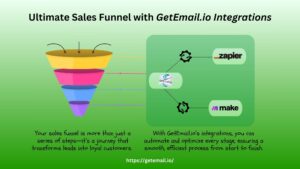
Do you measure email campaign success with GA4 or any other tracking tools? If not, how do you determine whether or not your email marketing strategies have been successful?
Do you know which of your email messages and links result in the highest number of conversions and the most traffic to your landing page?
Well, this blog is all about answering such questions and by the end of this piece of content you will be thorough with email tracking to a great extent.
So, keep reading till the end, if that’s what you came looking for.
Email is not Dead & Personalised Email is Powerful
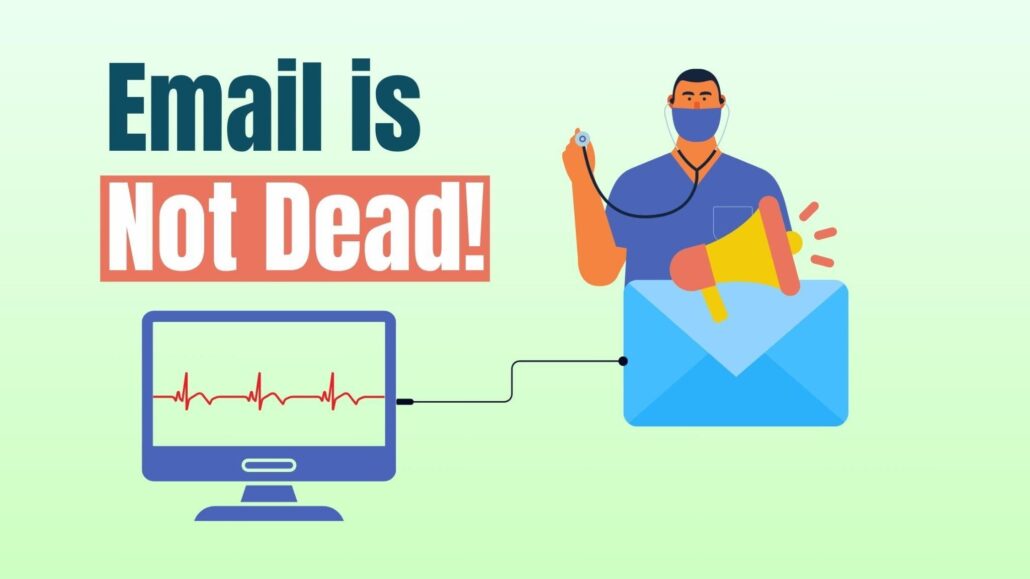
As you probably know, there are 4.3 billion people around the world who use email.
When companies spend one dollar on email marketing, they typically make 38 dollars in return.
This is called the ROI (Return on Investment) of email marketing, and it’s like getting back a lot more than you put in.
For example, MailChimp, a company that helps with email marketing, mentioned that their customers made 1.75 billion dollars in the first half of 2022 using email marketing.
They predict that by the end of 2023, the total money made through email marketing could reach as high as 8.7 billion dollars.
What does this mean?
It can be clearly understood that email marketing seems to be a really effective way for businesses to make money, with a good chance of making much more than they initially spend.
How well are you leveraging this super-effective marketing channel?
Now, here is a question – do you think all email campaigns yield a successful result?
Not really, right?
If you have a business and want to reach out to your customers effectively, using personalised emails can be really helpful.
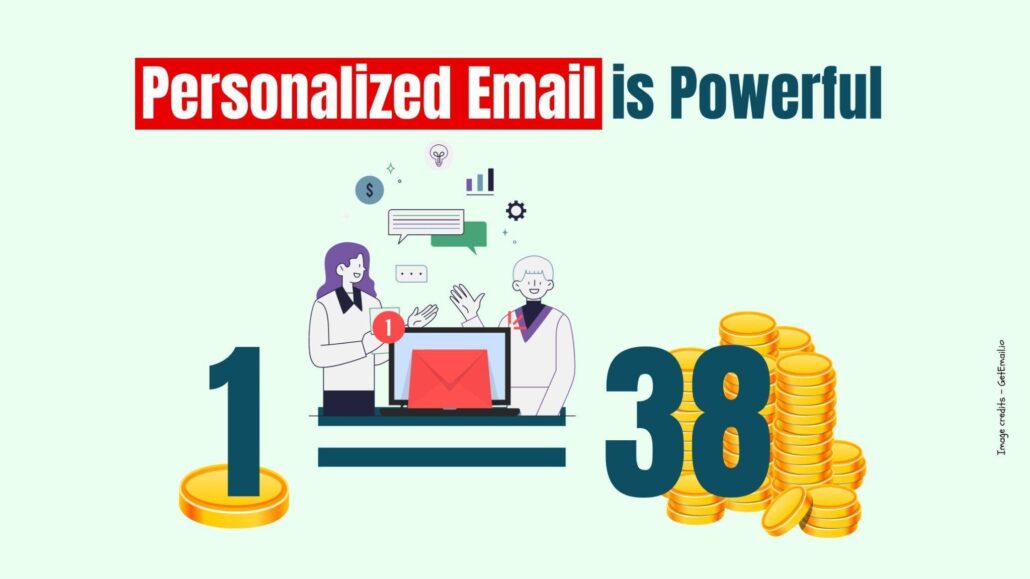
Even though there are many ways to promote your business, sending emails tailored to your customers’ needs is still a powerful strategy.
What Happens after you Launch the Email Campaign?

When you run advertising campaigns, you check how well they’re doing. Likewise, it’s also important to see how your customers are responding to the emails you send.
That’s what you do after launching your email campaign.
For instance, you might want to know how many people bought something because they received a specific email from you.
To get detailed information like this, you need a good system in place that can track your emails efficiently.
Luckily, Google Analytics is a free tool that can help you with that. It gives you a deep look into how people interact with your online space i.e., website.
As you continue reading this, we will guide you step by step on how to set up a system to measure email campaign success with GA4.
And by the end of the article, after you finish reading, you’ll be able to do it on your own.
Let us get deeper.
Email Tracking - Let’s Understand it!
Email tracking is the process or steps of activities you do after launching your email campaign, to be aware of the way your target audience are engaging with your emails;
- Whether they got the emails on their inbox or it ended up in the spam box
- Whether it got opened, if yes, when it was opened
- Did the recipient take any action such as replying back, clicking on the links, or make use of the exclusive coupon code for their next purchase, etc.
You can also be informed about whether your email leads the user (email recipient) to your website.
But why do you need all this information? That’s what the next section is all about.
Why is Tracking Email Marketing Campaign Crucial?
Here are some ways in which email marketing campaign tracking proves to be a valuable tool for your business.
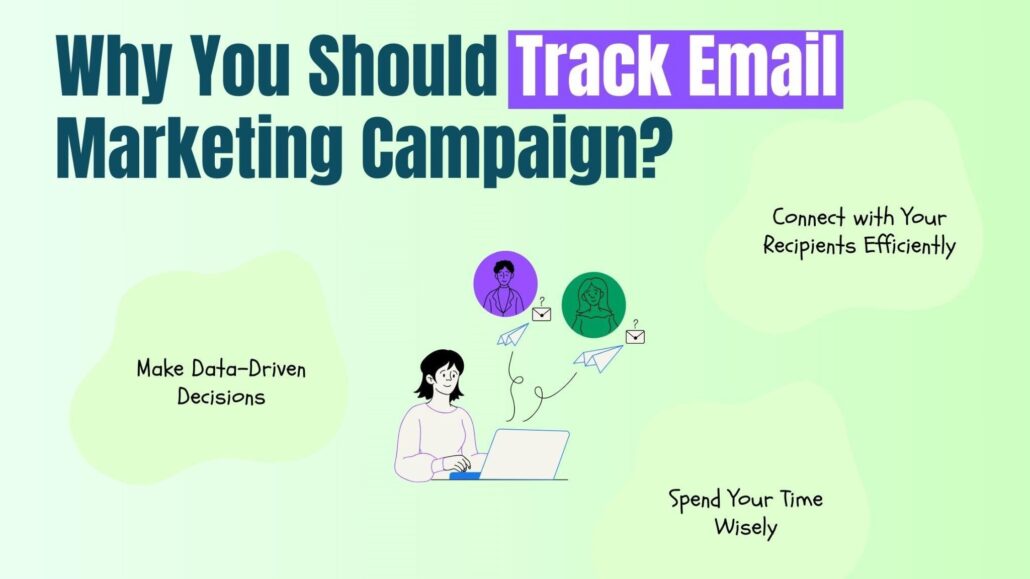
Make Decisions that are Data-Driven
You might know that data driven campaigns allow you to make smart decisions when it comes to your marketing tactics and strategy.
The same applies for the email marketing campaigns too. Once you have all the data pertaining to the campaigns you run, you can make logical decisions.
For example, you will be able to know the time frame in which each of your audience opens emails. With this, you can schedule your next campaign time in a way that it reaches their inbox when they are more likely to check their emails.
Does that make sense?
Connect with Your Recipients Efficiently
By leveraging meaningful data and insights, you gain a deep understanding of the email messages and offers that truly connect with your target audience.
This goes beyond just knowing which emails were opened — it delves into comprehending the nuances of what resonates well.
It’s about crafting messages in a highly personalized manner, tailored to the specific choices and interests of your recipients.
This level of understanding allows you to go beyond generic content and create emails that feel like a one-on-one conversation, establishing a stronger rapport with your audience.
Essentially, it’s not just about sending emails; it’s about sending the right emails that genuinely engage and resonate with the individuals you’re trying to reach.
Once you know which of your email campaigns worked out well, you can create more such campaigns and connect with your target groups efficiently.
Yeah, for this you need to do A/B testing.
Spend Your Time Wisely
If you use email tracking, you may see exactly who opened your emails and who didn’t right away.
What good does that do?
Now that you know this, you can save time by removing the email addresses of people who aren’t responding to your emails.
You can instead devote more time and energy on reaching out to those who open and click on your emails or are more likely to interact with them.
I hope that answers why tracking email marketing campaigns is vital.
Google Analytics - An Overview & Introduction
Google Analytics is a free service provided by Google for tracking and reporting on website traffic.
It goes beyond just counting visitors—it can also monitor various aspects of user engagement, like how long people stay on your site and whether they leave right away (known as the Bounce Rate).
Additionally, it identifies where your website traffic is coming from, such as specific sources or channels – say email, organic, paid.
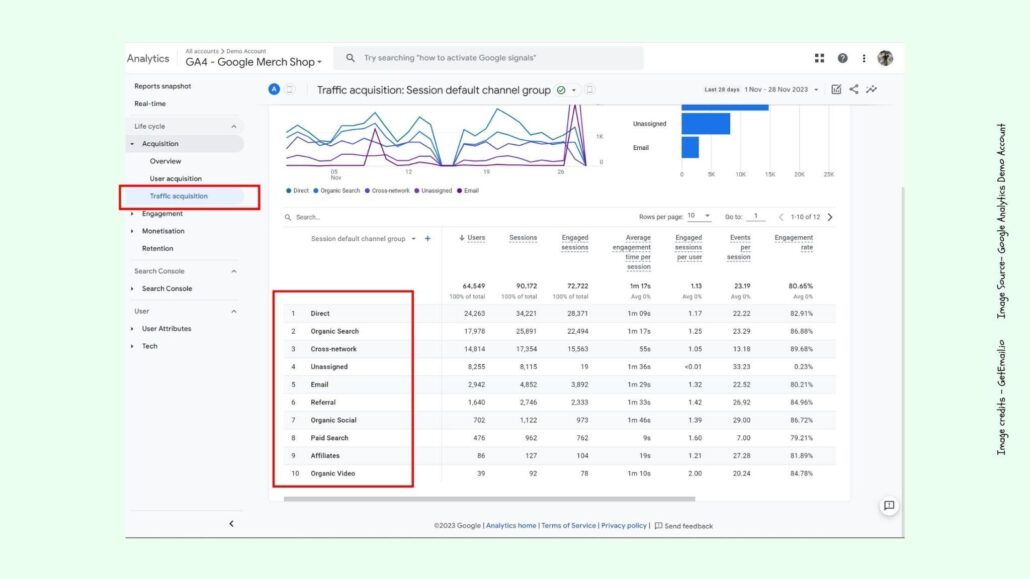
What sets Google Analytics apart and makes it a top choice in the industry is its robust reporting capabilities.
It’s not just about numbers; it provides valuable insights into user behaviour and helps you understand your online audience better.
By leveraging Google Analytics, you can manage and optimise your online presence more effectively.
The tool offers features that facilitate interaction with various platforms (refer to the image below) and enable the collection of crucial data from websites.
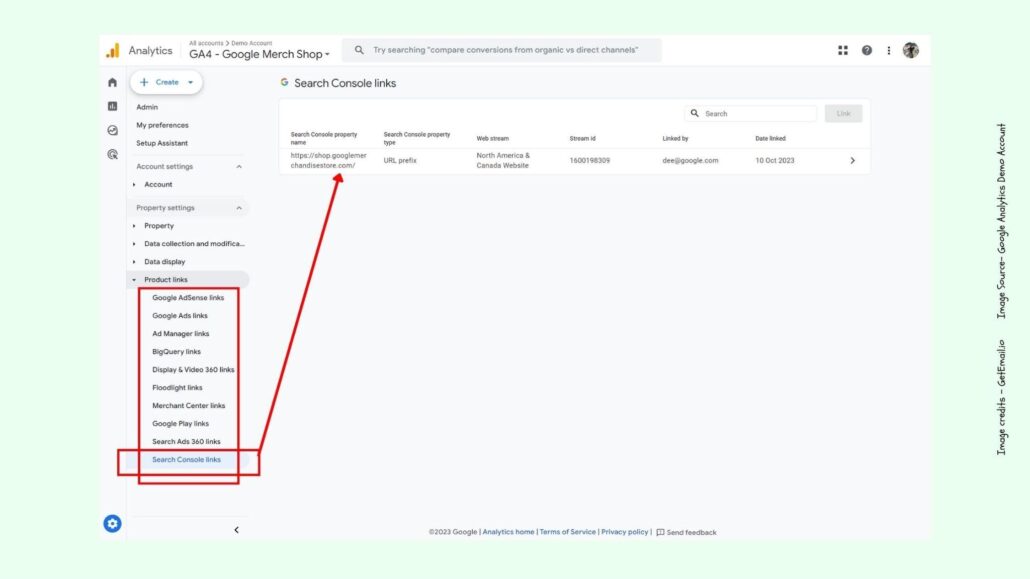
A notable aspect of Google Analytics is its ability to help users segment their campaigns based on different variables and help businesses break down their marketing efforts into distinct categories to analyse how each performs.
Armed with this detailed information, users can then make informed, data-driven decisions to enhance campaign performance and overall website optimization.
Essentially, Google Analytics empowers businesses to understand their online activities comprehensively and make strategic decisions based on real data.
Let us understand this with an example.
Imagine you own a lemonade stand, and you want to know which days of the week bring in the most customers.
While Google Analytics doesn’t create distinct categories for each time directly, it does allow you to analyse performance trends over time intervals, such as hours or days.
For instance, you can see if your website gets more visits during specific times of the day or days of the week.
With these time-based analyses, you can now see which times are the most popular for selling lemonade. Maybe people prefer it in the afternoon when it’s hotter. Google Analytics helps you understand how your sales perform over different time intervals.
Now that you have all this detailed information, you can make really smart decisions. If you find out that most people buy lemonade in the afternoon, you might decide to make more during that time. This is like making decisions based on real data, not just guessing.
Why should you use Google Analytics?
Want to know how people are using your website? Google Analytics has you covered.

If you’re into running email campaigns for your business, Google Analytics can help you figure out how well those emails are doing.
When we say “email traffic,” we mean visits to your website that happen because someone clicked on a link in an email you sent.
Google Analytics keeps track of these visits and connects them to the specific email that brought the person to your site.
So, you can see if your emails are doing a good job of bringing people to your website.
This helps separate the visitors who came from emails from those who found you through search engines.
It’s like having a special tag on visitors that says, “Hey, they’re here because of that email we sent!”
This way, you know what’s working and can make your website and emails even better.
Once you have determined which of your site visitors came from email, you can be able to carry out the analysis of the steps they took on your website after clicking on the email link.
Did they finish making a purchase, or left the shopping cart unfinished? In either case, this is vital information that can assist you in optimising the experience of using your website as well as the messages you send.
For instance, if you own a clothing brand, you may want to see how people are engaging with your website during this festive season of December, with Christmas and New Year around the corner.
You may send holiday themed email campaigns showcasing your latest clothing collections, with the help of Google Analytics, you can measure how well those emails are doing.
You can see the steps your recipients took after clicking the email link. Did they buy festive clothing or leave items in their shopping cart, maybe for a New Year’s Eve outfit?
This information is gold – Do you agree?
It helps you fine tune your messages to enhance the overall holiday shopping experience on your website.
I hope this example helped you to understand the context better.
There are a variety of other advantages that can be gained from using Google Analytics. Here are a few examples:
It’s possible to set goals for different pages on your website using Google Analytics.
When a visitor accomplishes the goal that was stated, Google Analytics records the event as a conversion with the system.
- This feature gives you the ability to monitor each and every step that a user takes while navigating through your website.
- It provides you with the ability to monitor the Marketing Performance, which in turn can direct the process of decision-making.
- Additionally, it offers in-depth insights that are associated with your marketing strategies.
- It provides you with the ability to visualise the data in the form of graphs and stats.
This should convince you to onboard Google Analytics to your email marketing strategy.
Now, let us take a look at how to get started with Google Analytics.
Steps to Set up Google Analytics for Email Tracking
You can follow the steps that are provided below if you intend to set up email tracking with Google Analytics, with the primary objective of measuring the amount of emails that are opened and clicked on.
- Create an account with Google Analytics as the first step.
- Create a Trackable URL as the second step.
- The next step is to include the URL in the email.
- Observe the Email Campaign in Real-time, which is the fourth step.
Let us discuss these steps in further detail one by one.
Step 1: Create an account with Google Analytics as the first step
A Google Analytics account is the first thing you need in order to get started with the process of setting up Google Analytics for tracking emails.
Do you have one?
If you haven’t set up a Google Analytics account yet, you can easily register for one now.
Accessing Google Analytics is possible with any Google Account; however, before you can commence collecting and analysing data, you need to set up a property (i.e., a website or App) and authenticate your ownership with a tracking code before you can start collecting and reviewing data.
First head to the Google Analytics register page.
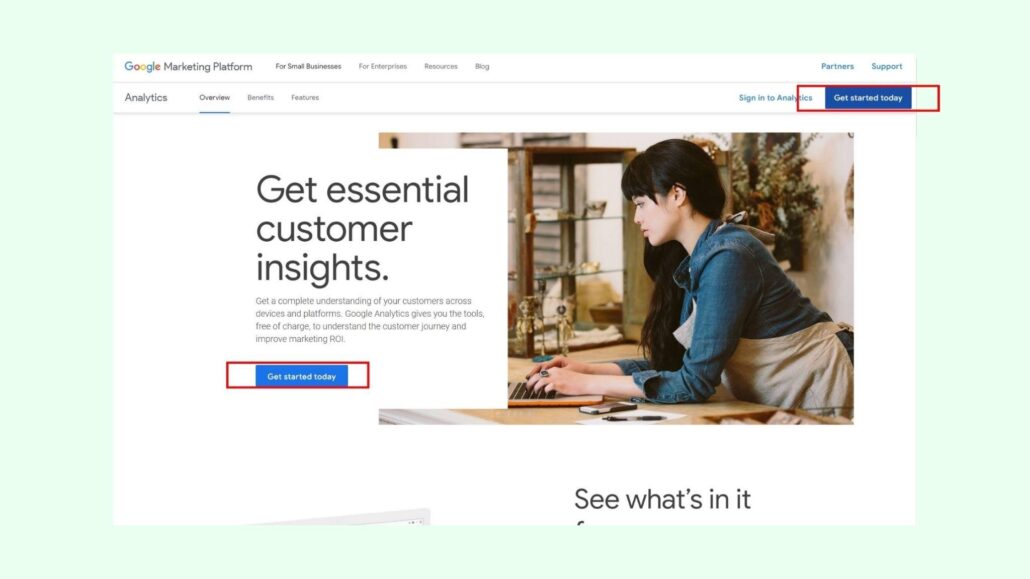
In the bottom left corner, you will see “Admin”. In Admin, you have the “Create” option, click on it and then select “Account”.
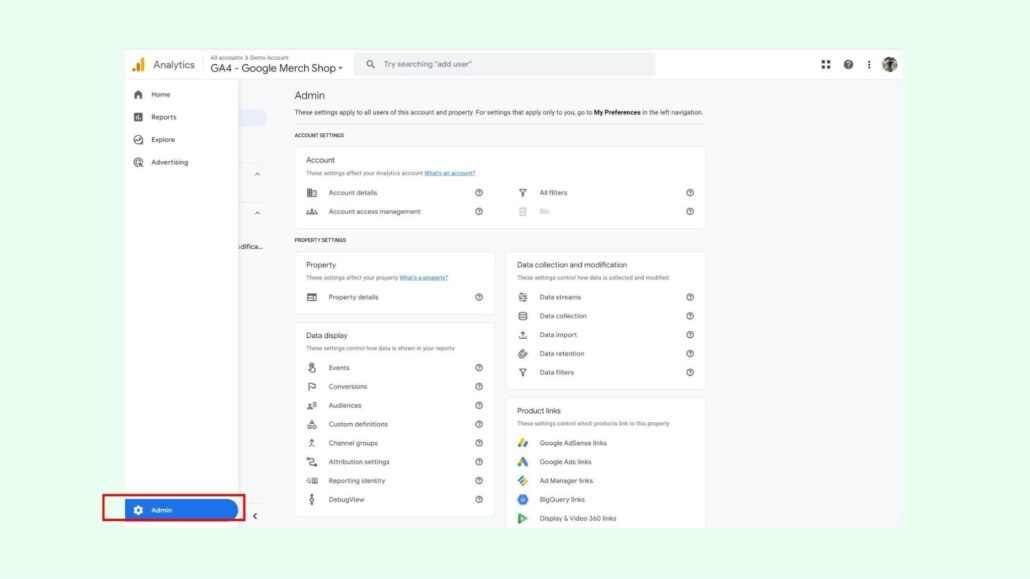

As highlighted in the below image, you have to enter an account name, configure the data-sharing settings and click next to further add your first property to the account.
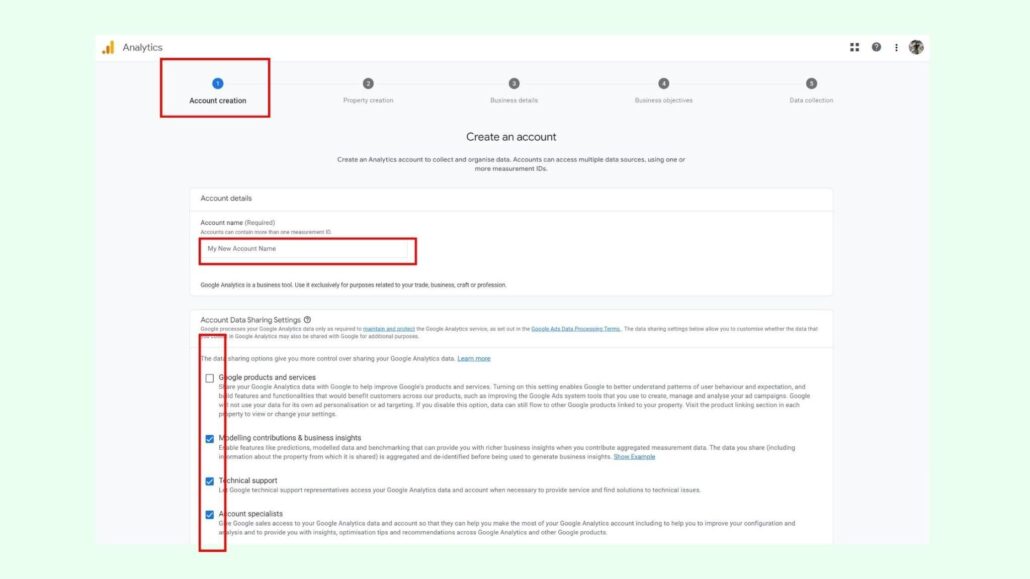
- Name your property (e.g., “My Business, Inc website”) and pick the time zone and currency. If someone visits your site on a Tuesday in their time zone, but it’s Monday in yours, it’s recorded as Monday. If you choose a time zone with Daylight Saving Time, Analytics adjusts for time changes. Use Greenwich Mean Time if you don’t want this adjustment.
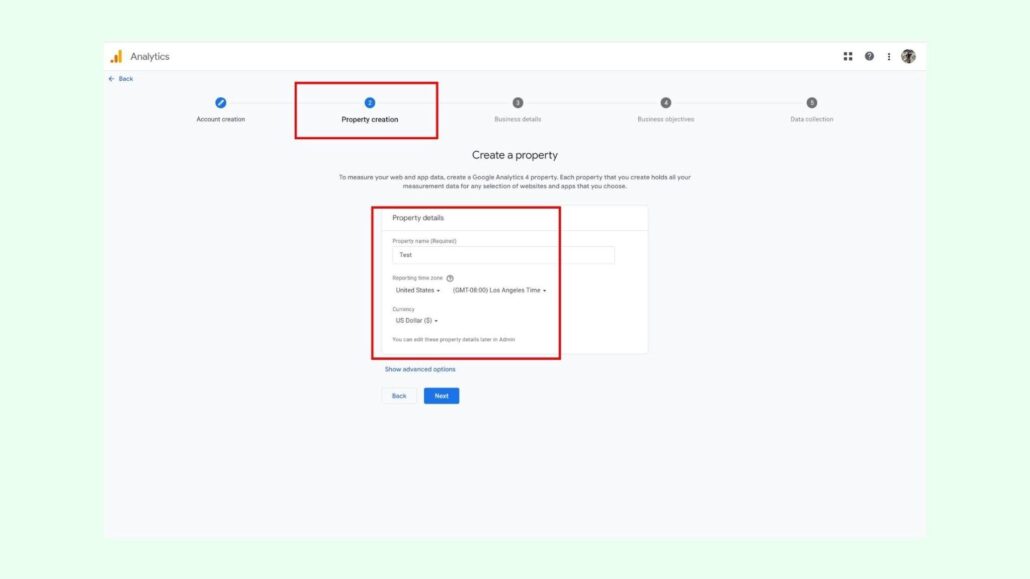
- Modifying the time zone impacts future statistics. If you adjust it for an already-existing property, time shifts may cause a spike or flat area in your data.
Data may refer to the old time zone briefly after the change until Analytics processes it. Change the time zone no more than once per day for Analytics to handle it.
- Click Next, pick your industry category and business size.
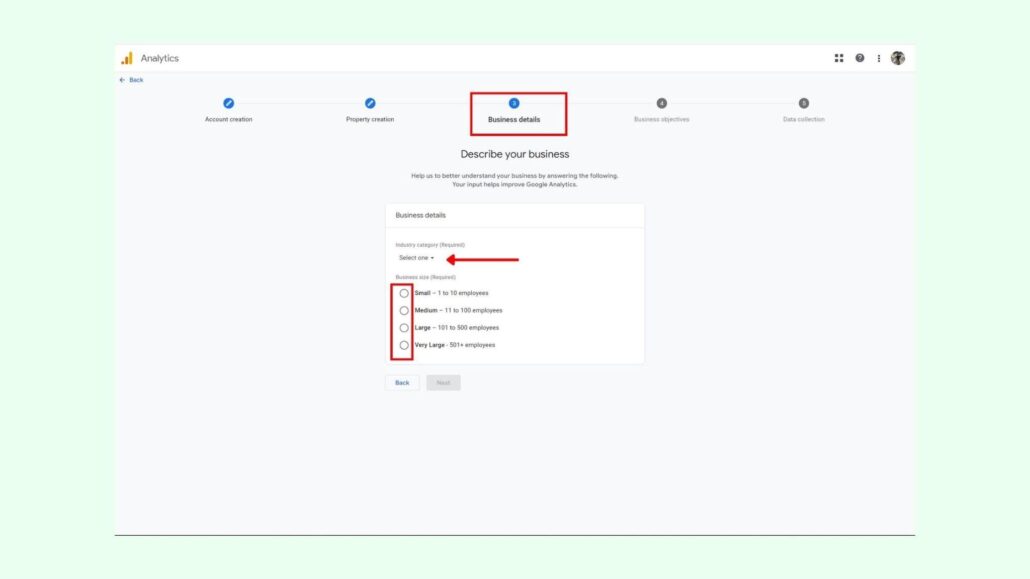
- Click Next, select how you’ll use Google Analytics.
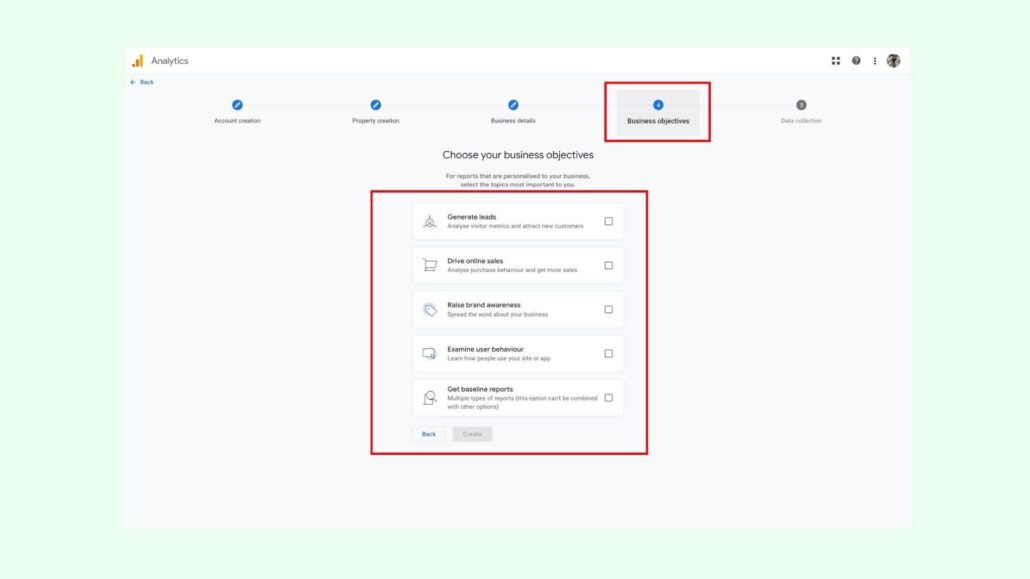
- Analytics tailors default reports based on your intended use. For instance, if you choose “Generate more leads,” you’ll see reports for measuring lead generation.
- Click Create, accept the Terms of Service, and add a data stream to start collecting data.
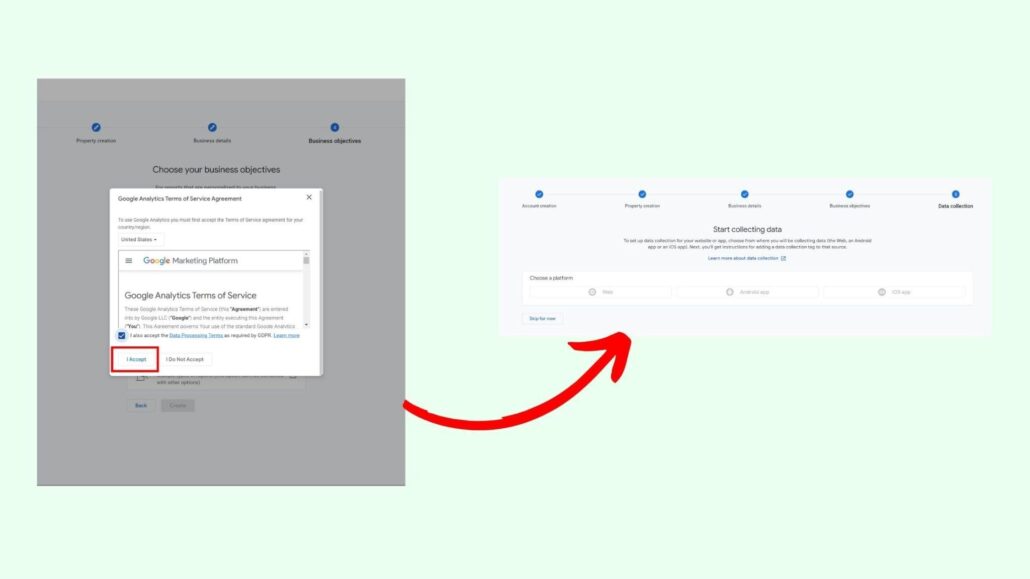
- Click iOS app, Android app, or Web.
- Finally, for websites, set up data collection by adding the Google tag right after the <head> to start seeing data in your Google Analytics 4 property.
Now how to get the Google Tag? Here is the flow you should follow Admin >> Property >> Data Streams >> Web >> Google Tag >> View Tag Instructions >> Install Manually
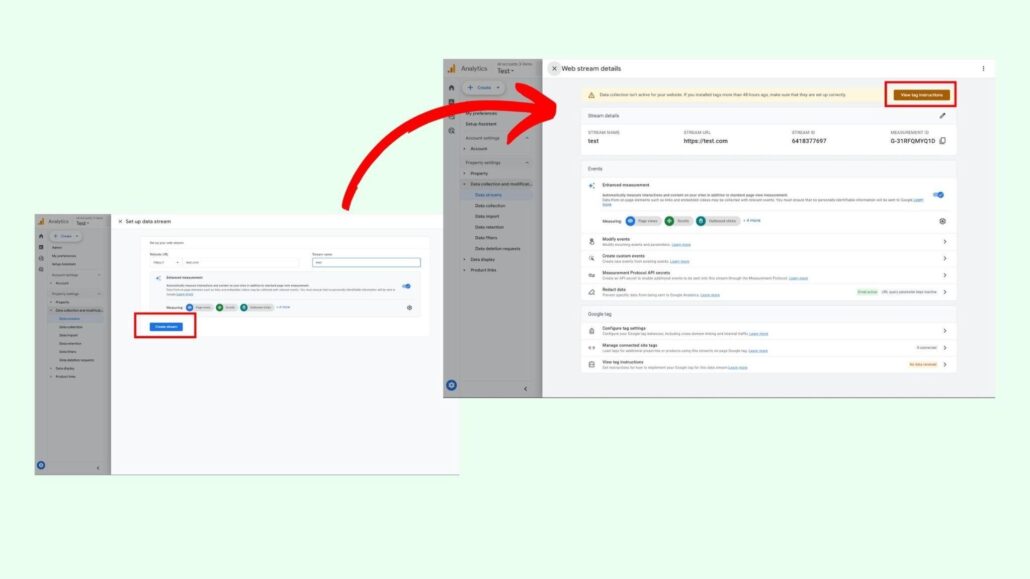
By following the above steps, you can effortlessly create a Google Analytics account.
Now you can commence the process of configuring email tracking.
Step 2: Create a Trackable URL for Email Campaign
The next step is to build a custom URL. (Tips – To do that, you can make use of Google’s Campaign URL Builder.)
A trackable URL requires certain Urchin Tracking Module (UTM) parameters to be filled in.
When you add UTM tags to the links in your email campaigns or newsletter, it allows Google Analytics to identify the traffic that is coming from these links to your website.
There are several ways to construct your personalised URL, and one of the options available to you is Google’s Campaign URL Builder.
This is a free tool designed for building links. By leveraging this tool, you can easily generate the custom URL you need for your tracking purposes.
You can accomplish this by following the steps that are outlined below:
- Open Google’s Campaign URL Builder in a browser of your choice.
- There are a few mandatory fields that you need to fill out when you arrive at the Campaign URL builders page. Once you have completed these fields, a URL will be generated for you automatically.
- In the section labeled “Website URL,” type in the complete URL of the landing page that you wish to direct your visitors to.
- In the area labeled “campaign source,” you have the option of entering the kind of email that you intend to send.
- In the area labeled “Campaign Medium,” you are required to input the medium that this campaign promotion will be conducted through, which in this instance is email.
- In accordance with your preferences, you are free to give the Campaign a name.
- A URL will be provided for you to use in order to measure the number of times your email is opened or links are clicked on if you have completed all of the steps outlined above in the correct order.
- After entering all of the necessary details, the URL that is generated is usually quite lengthy. The URL can be shortened in order to make it within the range of lengths that you desire. Click on the option that says “convert URL to short link” to accomplish this.
This is how you can create your custom trackable URL to set up Email Tracking Google Analytics.
Here is an image demonstrating how we generated the tracking URL for one of our email campaigns.
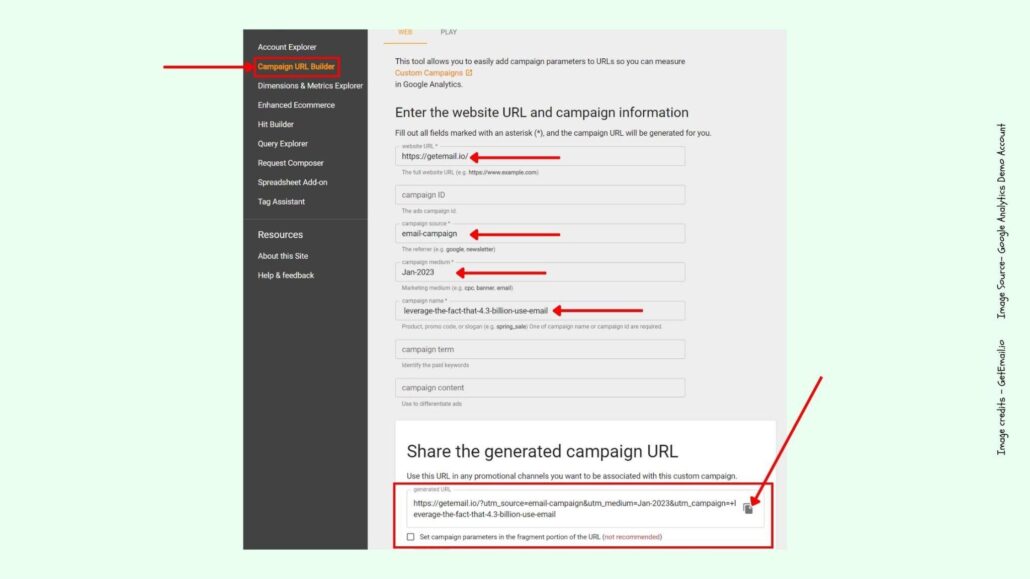
If you look at it carefully, you might notice that we have entered the mandatory fields alone and we choose the terms in a meaningful manner.
For example, the campaign source is named as email-campaign since it’s our email marketing campaign, in campaign medium we have mentioned “Jan’23” to indicate that it’s a campaign we ran in the month of January 2023, and under campaign name we mentioned the terms “leverage the fact that 4.3 billion use email” as a way to easily remember the context of our email.
Does that help you in creating a UTM URL for your campaign?
Step 3: The next step is to include the URL in the email
After successfully generating a trackable URL, the next step in the process of setting up Google Analytics email tracking is to incorporate the URL into the email.
Simply copying and pasting the URL into the body of the email is not a recommended approach.
The alternative is to send the prospect an email with the URL embedded in some meaningful content within the body of the message.
Here is an example of one of our email campaigns that we ran, highlighting the total population using emails and how our recipients should leverage this to generate leads.
Subject: 8 billion people in the world & half of it are email users!
Body:
Hello XXX,
Are you prepared to leverage the fact that 4.3 billion use email?
With half the world’s population using email, it’s imperative that companies and email marketers are well prepared to capitalise on this media; the best way to do this is to begin constructing an email list.
Our free version is a great way to get started, it allows you to find a hundred email addresses.
Just install the GetEmail.io extension and avail this.
So, this is how you should insert your trackable URL for your Email Campaign to set up email tracking in Google Analytics, instead of directly pasting the URL as part of the texts.
I hope this example helps!
Now you may wonder if you should just add the UTM codes to your home page.
Not necessarily! You can put UTM parameters to any URL in your website, not just your main domain or home page.
- You may, for example, direct users to a sub-page on your site, such as https://getemail.io/blog/.
Step 4: Real-Time Tracking of the Email Campaign
You will be able to begin monitoring the campaign once you have completed all of the stages that were outlined above.
Going to Google Analytics and following the procedures that are listed below is all that is required:
The Real-Time option may be found in the panel on the left; select it by clicking on it.
- Take a look at the Active User count. An increase in this number may indicate that prospects are clicking on the link provided in the email.
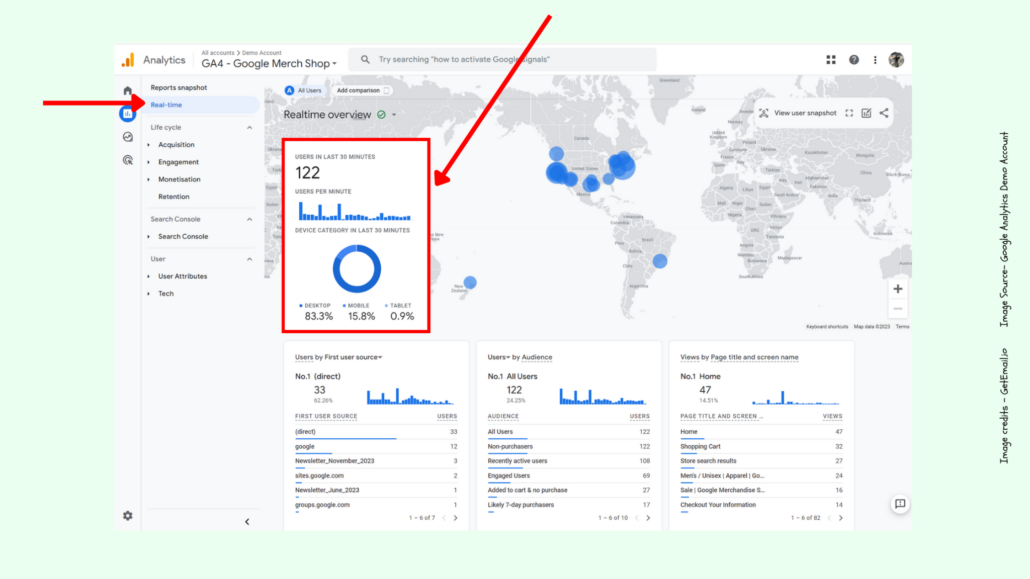
- You can also look at where the traffic is coming from and how it comes in.
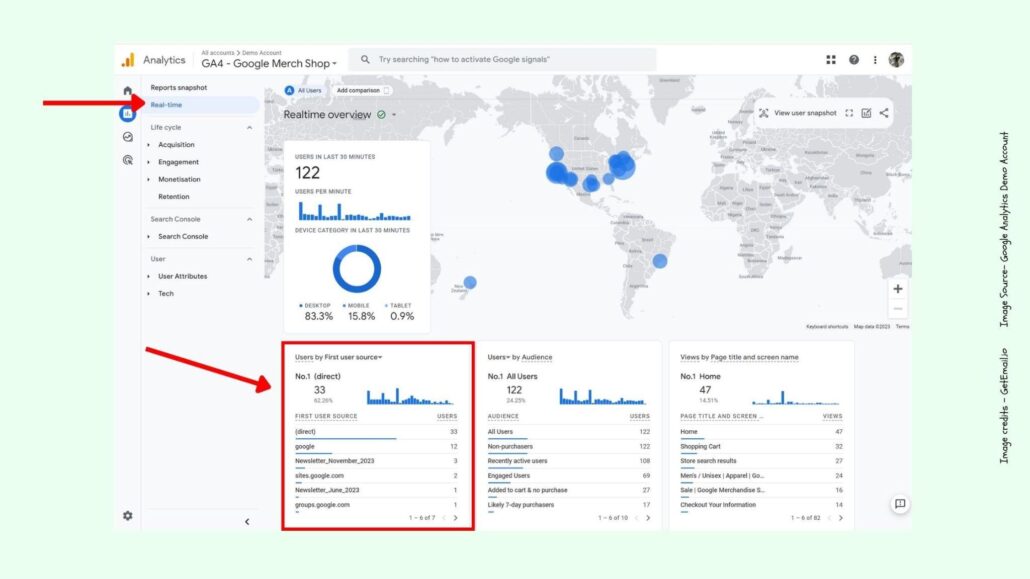
- After following these steps, you can start tracking how well your Email Ad Campaign is doing in Google Analytics.
But that’s not the only way to monitor the traffic from email marketing.
Access the Reports » Acquisition tab in your Google Analytics 4 account to see which users clicked on your email links and ended up visiting your site.
First, navigate to the Reports menu and select Acquisition. From there, select Traffic Acquisition. This will allow you to view a summary of the traffic coming from all of the channel sources, as depicted in the figure below.
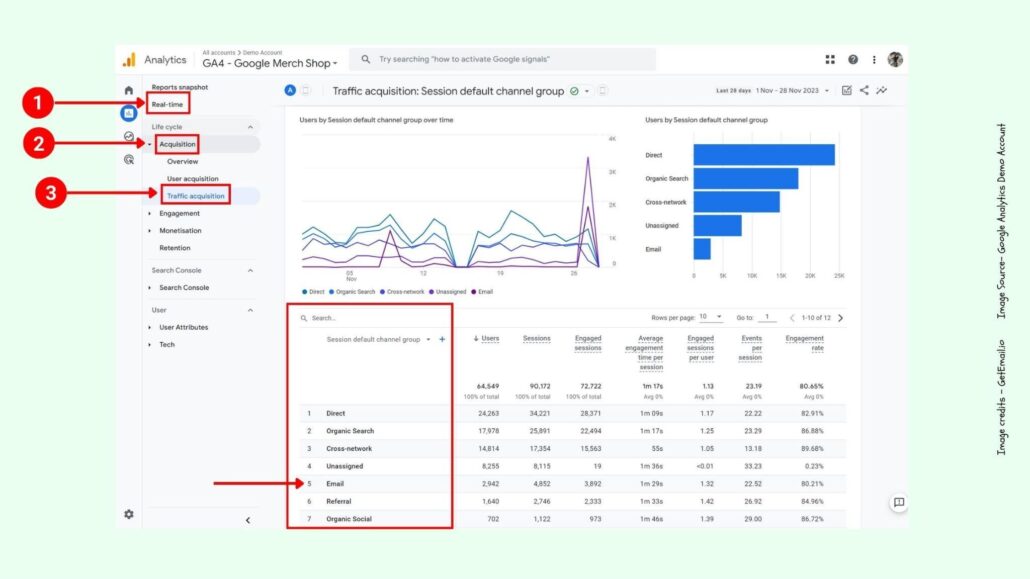
Can we track every aspect of an email campaign using Google Analytics?
Well the answer is! With this robust and free tool, most of the essential parameters that contribute to the success of your email campaign could be tracked.
Google Analytics when paired with your email campaigns, it becomes really smart. It can count how many people visit your website because of your emails, see if they stay or leave quickly, highlight the pages they like the most, and even check if they do the things you want them to do, such as making a purchase or filling out a form.
It’s like having a detailed report card for your email campaigns, giving you insights into what’s working well and where you can make improvements. It’s your guide to making your email campaigns and website a success.
However, there are a number of email marketing platforms that come with built-in analytics, which enables you to audit the performance of your email campaign. Some examples of such tools include GetEmail.io, MailChimp, and another similar service.
Yes, GetEmail.io, our Artificial Intelligence based email lookup tool, boasts an exceptional add-on feature. This feature allows users to track details like whether or not their email was delivered to the people they intended to receive it, whether or not they opened it, and when was the last time they opened it, etc.
You could give it a try and see the result by yourself.
Concluding Thoughts
In today’s busy business world, where many strategies are competing for attention, using personalized emails that focus on customers is a strong way to advertise products and services.
Among the various ways to market, it’s important to know how people react to your emails, especially how they affect whether someone buys something.
To understand these reactions better, as discussed in this blog, it is necessary to make use of an advanced email tracking system.
As mentioned before, Google Analytics is a powerful tool that gives a detailed look at your online presence.
The main goal of an email tracking system is to help companies and marketers like you understand the traffic and sales that come from your email campaigns.
With this information, you can make adjustments to your email marketing plans or strategies to make your website more popular.
To sum up the important points in this article:
- Importance of personalised emails: Even though there are many ways to market, using emails that are highly personal and customer-focused is still effective.
- Email Tracking Systems: It’s important for businesses to have a sophisticated email tracking system to understand how subscribers react to their emails.
Google Analytics is a strong choice for this. It’s free too!
- Overview of Google Analytics: This article briefly explains the main features and reasons to use Google Analytics. It emphasises how it helps in understanding your users activity on websites or emails.
- Email Tracking with Google Analytics: We walked through the steps needed to set up email tracking using Google Analytics and measure your email campaign success with GA4, highlighting how it can refine your marketing strategies.
- GetEmail.io’s Feature: We also took a glimpse of a cool feature of GetEmail.io that tracks email deliverability and open status, adding more insights to the email tracking process.
I hope this blog piece helped you to fully understand email tracking with Google Analytics.
By applying the process discussed here, businesses and marketers like you can make your email campaigns better, improve how emails are delivered, and ultimately strengthen your online presence and sales using a good email marketing campaign.
If you liked reading this, you might also be interested in my other blog posts as well. Here are links for your easy reference:
Email Marketing – Expectations Vs Reality
AI in Email Marketing: What You Need to Know?
20+ Email Marketing Stats You Need to Know in 2023
How to extract emails from any websites?






